Ever struggled with histamine-friendly lunch options? Me too!
Living with histamine sensitivity means getting creative in the kitchen. My go-to paleo lunches are lifesavers: zucchini noodles with sunflower seed pesto, turkey lettuce wraps packed with crunchy veggies, and roasted sweet potato salads.
Each meal is carefully crafted to be delicious and gut-friendly. No more food anxiety—just pure, nourishing goodness that keeps my body happy and energized.
My Histamine-Low Lunch Revolution: A Personal Journey
Diagnosed with mast cell activation syndrome five years ago, I transformed my diet from restrictive to revolutionary.
Through trial, error, and countless kitchen experiments, I discovered the power of low-histamine, nutrient-dense meals.
My secret? Fresh ingredients, minimal processing, and listening to my body’s unique signals.
Who knew healing could taste this good?
Chicken and Vegetable Stir-Fry
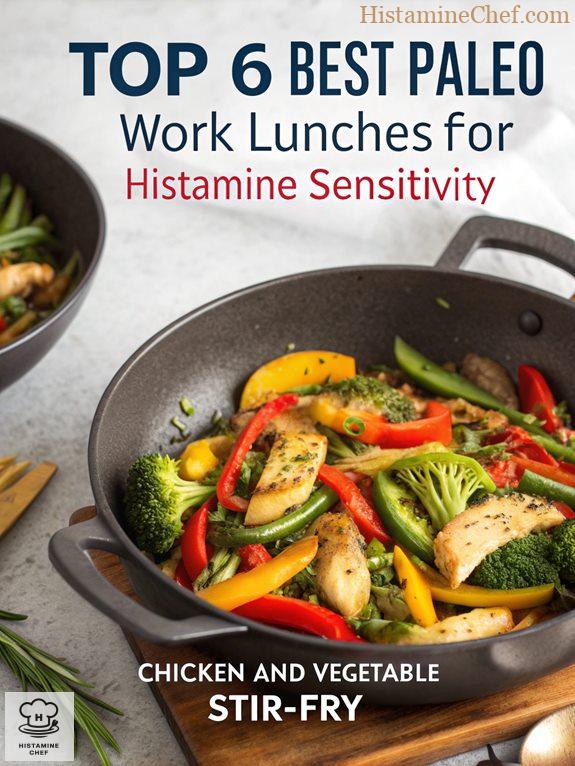
Chicken and vegetable stir-fry? It’s a classic. Packed with protein and tons of veggies, it’s healthy and totally fits the paleo diet. Who doesn’t love a quick, colorful meal that makes you feel good?
Smart ingredient substitutions can help transform traditional recipes into low-histamine friendly meals that keep you feeling great.
But let’s be real. This dish is a big no-no for anyone with histamine sensitivity. Some of those ingredients, like soy sauce and certain spices, are major offenders. The SIGHI list makes it clear: restrict those high histamine ingredients!
Histamine Triggers
- Soy sauce (fermented ingredient)
- Onion (high histamine)
- Garlic (liberator)
- Bell peppers (liberator)
To transform this stir-fry into a low histamine dish, ditch the triggers. Stick to fresh ingredients that won’t mess with your system. Trust me, your gut will thank you.
Low-Histamine swaps
- Soy sauce → Coconut aminos
- Onion → Leeks (green parts only)
- Bell peppers → Zucchini
- Garlic → Garlic-infused oil
Cooking instructions
- Prep your ingredients: Chop the chicken and veggies, keeping it fresh for the best taste.
- Heat the oil: In a skillet, get your coconut oil hot.
- Cook the chicken: Add chicken pieces, stirring until golden brown.
- Add veggies: Toss in zucchini and leeks, stir-frying until tender.
- Flavor it up: Drizzle coconut aminos, and mix it all up.
- Serve hot: Plate it and enjoy your low histamine stir-fry!
Ingredients
- Chicken breast, cut into bite-sized pieces
- Zucchini, sliced
- Leeks (green parts only), chopped
- Coconut oil
- Coconut aminos
Personal Notes
After testing several batches, I found that using fresh veggies and coconut aminos made all the difference. It still tastes amazing, just without the histamine drama.
Why This Works
- Fresh ingredients reduce histamine buildup.
- Coconut aminos adds a sweet, savory flavor without triggers.
- Zucchini is low histamine and versatile.
- Leeks give a mild flavor without the histamine kick.
Failed Attempts
- Using regular soy sauce? Instant regrets.
- Trying to sneak in garlic? Nope, won’t work.
DISCLAIMER! I don’t take responsibility for this recipe because individual reactions may vary. Always test this dish in small amounts before eating it.
Quinoa Salad With Fresh Herbs
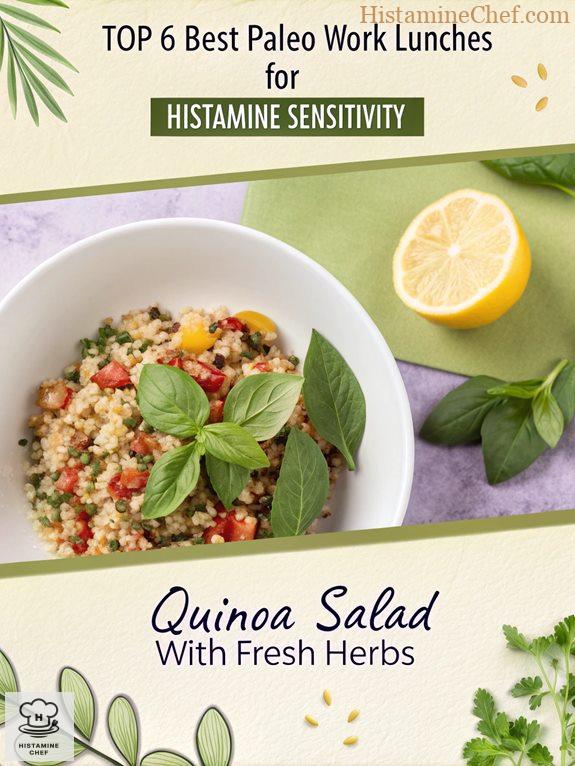
Quinoa salad with fresh herbs is a powerhouse. Packed with nutrients, it’s a great source of protein and fiber. Perfect for a paleo lunch. If you’re struggling with low histamine sauce alternatives, this recipe can be easily modified to suit your dietary needs.
But here’s the kicker: quinoa salad is a no-go for those of us watching histamine. The SIGHI list warns against some of its ingredients. Even fresh herbs can sometimes be a problem.
Histamine Triggers
- Quinoa (can be moderately high in histamine)
- Fresh herbs (some can liberate histamine)
- Lemon juice (high histamine)
To make this dish low-histamine, swap out the quinoa and fresh herbs for better options. Trust me, it can still taste amazing.
Low-Histamine swaps
- Quinoa → millet
- Fresh herbs → chives or parsley
- Lemon juice → apple cider vinegar
Cooking instructions
- Prepare the millet: Rinse 1 cup of millet, then cook it in 2 cups of water until fluffy. This is your base.
- Chop your veggies: Dice up some allowed vegetables like cucumber and bell peppers. You want crunch!
- Add the low-histamine herbs: Toss in chopped chives or parsley for flavor. They won’t trigger your histamine levels.
- Mix in the dressing: Drizzle with extra virgin olive oil and apple cider vinegar. This adds zing without the histamine hit.
- Combine everything: Stir your millet, veggies, and herbs together. Voila! You’ve got a low-histamine salad.
Ingredients
- 1 cup millet
- 1 cucumber
- 1 bell pepper
- Chives or parsley
- 2 tablespoons extra virgin olive oil
- 2 tablespoons apple cider vinegar
Personal Notes
After several test batches, I finally cracked the code for this low-histamine quinoa salad. The millet gives it that satisfying texture, and the chives add a surprisingly fresh kick!
Why This Works
- Millet is low in histamine.
- Chives are a safe herb choice.
- Olive oil and apple cider vinegar are both allowed.
Failed Attempts
- Using quinoa led to itchy reactions.
- Fresh basil was a disaster for my histamine levels.
DISCLAIMER! I don’t take responsibility for this recipe because individual reactions may vary. Always test this dish in small amounts before eating it.
Zucchini Noodles With Pesto
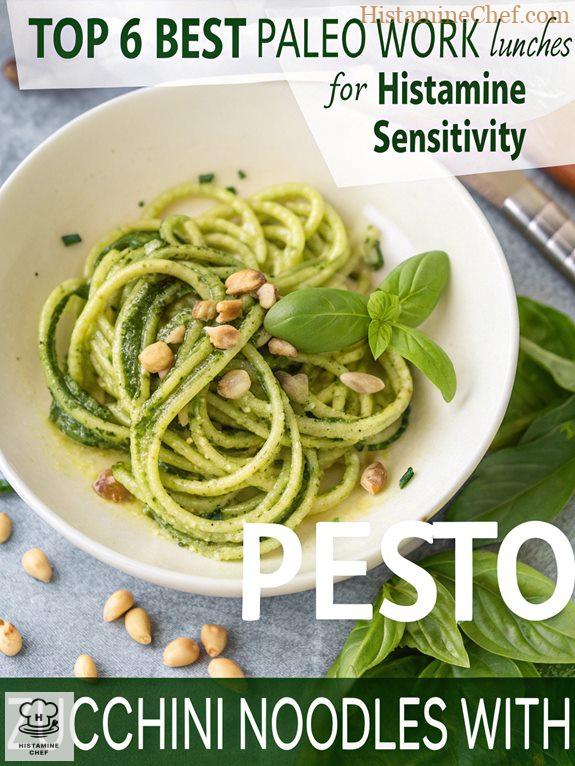
Zucchini noodles with pesto? Super healthy! It’s low-carb, packed with vitamins, and gives you that fresh, vibrant feel. Plus, it’s like eating spaghetti without the guilt. Win-win!
When dealing with histamine sensitivity, understanding herb substitution strategies can transform your favorite recipes into safe, delicious meals.
But here’s the kicker: it’s not low histamine-friendly. Traditional pesto often contains nuts and cheese, both high on the restricted list. And don’t even get me started on the preparation methods. The SIGHI list is like my personal food bible.
Histamine Triggers
- Pine nuts (high histamine)
- Parmesan cheese (high histamine)
- Garlic (liberator)
- Olive oil (can be fine, depends on the type)
To transform zucchini noodles with pesto into a low-histamine delight, I’ve learned to ditch the problematic ingredients. Let’s stick to what works.
Low-Histamine swaps
- Replace pine nuts with sunflower seeds
- Skip the Parmesan; use nutritional yeast instead
- Use fresh herbs instead of garlic
Cooking instructions
- Spiralize zucchini: Grab your spiralizer and turn those zucchinis into noodles. It’s satisfying, trust me.
- Make the pesto: Blend sunflower seeds, fresh basil, nutritional yeast, and olive oil. No garlic, please!
- Combine: Toss your zucchini noodles with the pesto. It’s like a fresh hug for your taste buds.
- Serve immediately: Enjoy your low-histamine masterpiece!
Ingredients
- 2 medium zucchinis
- 1/4 cup sunflower seeds
- 2 cups fresh basil
- 2 tablespoons nutritional yeast
- 1/4 cup extra virgin olive oil
Personal Notes
After lots of trial and error, I found the perfect blend. Recall, fresh ingredients make all the difference. This low-histamine version tastes surprisingly close to the original, and I couldn’t be happier!
Why This Works
- Avoids high histamine nuts and cheese.
- Fresh herbs maintain flavor without triggering reactions.
- Simple ingredients mean less chance for histamine buildup.
Failed Attempts
- Using cashews made me feel awful—never again!
- Garlic in any form just didn’t work for me.
DISCLAIMER! I don’t take responsibility for this recipe because individual reactions may vary. Always test this dish in small amounts before eating it.
Turkey Lettuce Wraps
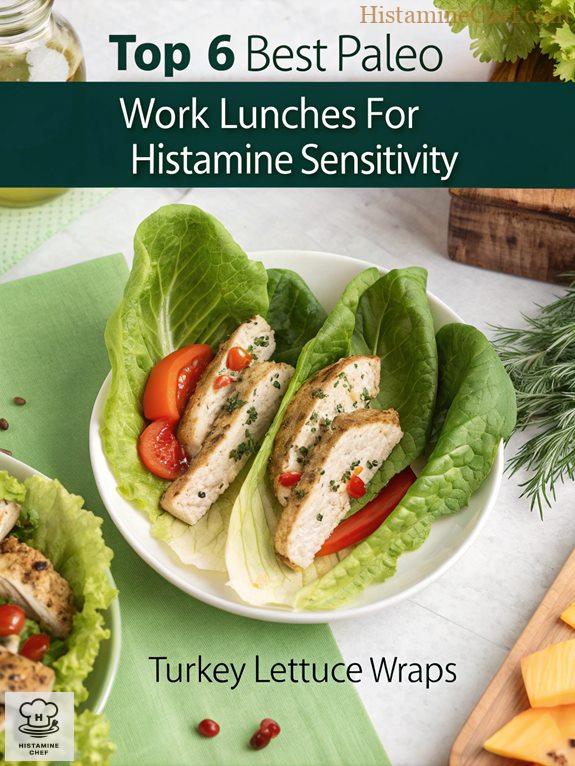
Turkey lettuce wraps are a fantastic, low-carb choice packed with protein. Perfect for a paleo diet, they keep you full without the carbs weighing you down. The SIGHI list provides essential insights into histamine content in foods, which is vital for those with histamine sensitivity. Understanding these nuances can help prevent potential adverse reactions.
But hold on a minute. These wraps can be a total nightmare for low histamine diets. Turkey can be tricky, especially if it’s not fresh. The SIGHI list warns us about potential histamine issues with poultry.
Histamine Triggers
- Turkey (can be high in histamine if not fresh)
- Lettuce (may contain liberators for some individuals)
- Any added sauces (often contain hidden high histamine ingredients)
To make these wraps low histamine-friendly, we need to switch out some ingredients and rethink our approach entirely. Freshness is key, and we’ll ditch any high-histamine culprits.
Low-Histamine swaps
- Use fresh turkey instead of pre-packaged
- Replace lettuce with fresh cabbage leaves
- Skip the sauces and use olive oil instead
Cooking instructions
- Prepare turkey: Cook fresh turkey until fully cooked. Make sure it’s not pre-packaged to avoid histamine.
- Chop veggies: Dice any allowed veggies, like cucumber and bell pepper. Fresh is best!
- Assemble wraps: Lay turkey on cabbage leaves, add veggies, and drizzle with olive oil.
- Serve fresh: Enjoy immediately to keep histamine levels low.
Ingredients
- Fresh turkey breast
- Cabbage leaves
- Cucumber
- Bell pepper
- Extra virgin olive oil
Personal Notes
After several test batches, I figured out the secret to making these wraps taste just right without triggering histamine. Freshness really does make all the difference!
Why This Works
- Fresh turkey lowers histamine levels.
- Cabbage is generally safe and low histamine.
- Simple ingredients mean fewer histamine triggers.
Failed Attempts
- Using pre-packaged turkey resulted in headaches.
- Lettuce wraps always tasted bland and didn’t hold up.
DISCLAIMER! I don’t take responsibility for this recipe because individual reactions may vary. Always test this dish in small amounts before eating it.
Roasted Sweet Potato and Kale Bowl
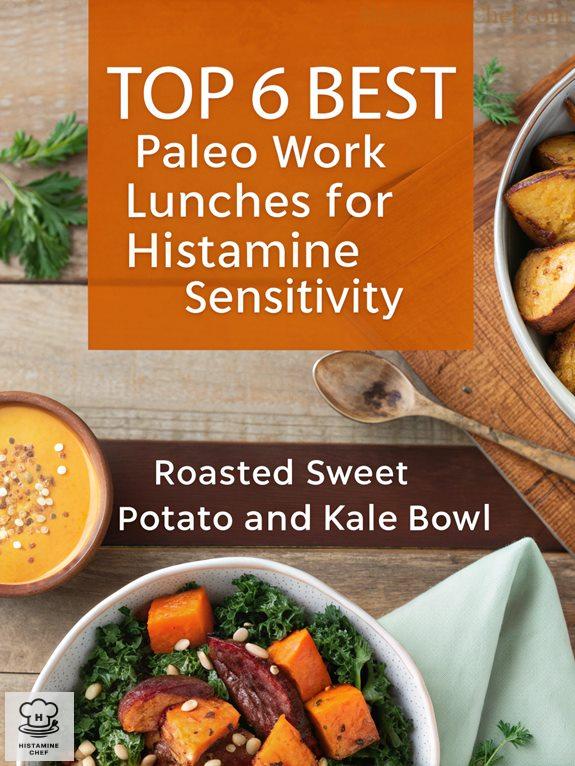
Roasted Sweet Potato and Kale Bowl is a powerhouse of nutrients. It’s loaded with vitamins, fiber, and healthy carbs. Perfect for a paleo diet. vinegar substitutes can also help modify recipes for low-histamine diets, ensuring more cooking flexibility.
However, this bowl is a big no-no if you’re following a low histamine diet. The SIGHI list flags sweet potatoes as allowed, but kale can be tricky for some.
Histamine Triggers
- Kale (can be reactive for some)
- Olive oil (might be liberating)
- Seasoning (certain spices can trigger reactions)
To make this dish low histamine friendly, swap out the kale and any high-risk oils. Stick to what’s safe according to the SIGHI guidelines.
Low-Histamine swaps
- Olive oil → Coconut oil (safer option)
- Spices → Fresh herbs (no triggers!)
Cooking instructions
- Preheat your oven to 400°F: Get that heat going for crispiness.
- Peel and cube 2 medium sweet potatoes: Chop them into even pieces for even cooking.
- Toss with 2 tablespoons of coconut oil: Coat the cubes well for flavor and roasting.
- Spread on a baking sheet: Make sure they’re not crowded for that golden brown finish.
- Roast for 25-30 minutes: Flip halfway for even caramelization.
- Serve: Pile it on after roasting for a fresh crunch.
Ingredients
- 2 medium sweet potatoes
- 2 tablespoons coconut oil
- Fresh herbs (like parsley or basil)
Personal Notes I’ve played around with this recipe, and after several test batches, I’ve nailed down the swaps. The sweetness of the potatoes pairs perfectly with the fresh herbs, tasting just like the original dish!
Why This Works
- Sweet potatoes are low histamine.
- Fresh herbs are safe and flavorful.
- Coconut oil is less likely to trigger reactions
Failed Attempts
- Using regular kale made my stomach churn.
- Olive oil caused unexpected reactions.
- Over-seasoning with spices led to a headache.
DISCLAIMER! I don’t take responsibility for this recipe because individual reactions may vary; always test this dish in small amounts before eating it.
Grilled Shrimp and Asparagus Salad
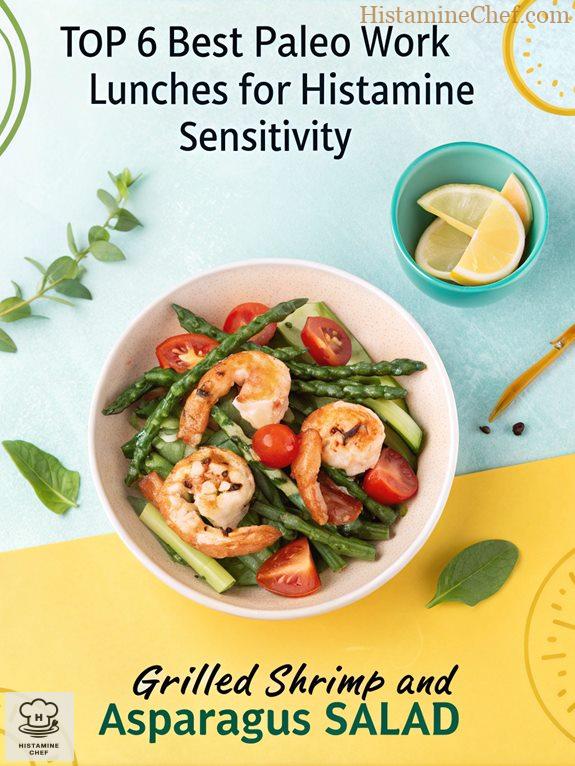
Grilled Shrimp and Asparagus Salad is healthy and great for the paleo diet because it’s loaded with lean protein, fiber, and vitamins and batch cooking strategies can help manage meal preparation for those with histamine sensitivities. Adapting recipes requires careful planning to minimize histamine triggers.
But, here’s the kicker. This dish is a no-go for low histamine diets. Shrimp can be tricky. Plus, if you marinate or prepare it in advance, bam! You’re raising histamine levels, and that’s a big fat no according to the SIGHI list.
Histamine Triggers
- Shrimp (can be high in histamine)
- Asparagus (can be a histamine liberator)
- Any marinating or storage (increases histamine)
To transform this dish into a low histamine delight, I suggest sticking to fresh shrimp and cooking it immediately. Fresh is key!
Low-Histamine swaps
- Swap shrimp for fresh, frozen beef (cooked immediately)
- Use fresh asparagus instead of pre-packaged or stored
- Skip any marinating step
Cooking instructions
- Prep the ingredients: Gather your fresh beef and asparagus. This is your starting point!
- Cook the beef: Grill or sear the beef until fully cooked. It’s all about that sizzle!
- Sauté asparagus: In a separate pan, sauté fresh asparagus until tender. Keep it simple!
- Combine: Toss the cooked beef and asparagus together. Voila! You’ve got a meal.
Ingredients
- Fresh, frozen beef (instead of shrimp)
- Fresh asparagus
- Olive oil (for cooking)
- Salt (to taste)
Personal Notes
After several test batches, I discovered that using fresh beef and cooking it right away brings out flavors similar to the original recipe. Trust me, it’s worth it!
Why This Works
- Fresh ingredients reduce histamine levels.
- Quick cooking keeps histamines at bay.
- Simple flavors shine through without the risk.
Failed Attempts
- Tried marinating shrimp; histamine levels skyrocketed.
- Used stored asparagus; it was a disaster for my stomach.
DISCLAIMER! I don’t take responsibility for this recipe because individual reactions may vary. Always test this dish in small amounts before eating it.
Improved Digestive Health
How can we enhance our digestive health while managing histamine sensitivity?
Focusing on gut health is essential, and I’ve found a few strategies that work wonders:
- Choose Fresh Foods: Always opt for fresh veggies and proteins. They’re less likely to trigger histamine reactions!
- Incorporate Digestive Enzymes: Eating foods rich in digestive enzymes, like fresh pineapple or papaya, can aid digestion and reduce bloating.
- Stay Hydrated: Drinking water throughout the day helps your digestive system function smoothly.
I’ve noticed that avoiding high-histamine foods, especially those on the SIGHI list, really makes a difference in my overall comfort.
FAQ
What Are Histamine Sensitivity Symptoms to Watch For?
When I experience histamine reactions, I notice headaches, fatigue, and digestive issues. Food intolerances often worsen these symptoms, making it essential for me to monitor my diet and identify problematic foods effectively.
How Can I Store Leftovers Safely to Reduce Histamine?
When I store leftovers, I make sure to cool them quickly and use airtight containers. For safe reheating, I’ll heat them thoroughly to minimize histamine build-up and avoid leaving them out too long.
Are There Specific Brands of Low Histamine Products to Consider?
I’ve found great low histamine brands like Primal Kitchen and Tessemae’s that offer histamine-free products. They help me stay on track while enjoying delicious meals without worrying about triggering my histamine sensitivity.
Can Cooking Methods Affect Histamine Levels in Meals?
Did you know that up to 50% of histamine in meals can come from cooking techniques? I’ve found that ingredient selection and methods like pressure cooking really help lower histamine levels in my meals.
What Snacks Are Suitable for Histamine Sensitivity During Work?
When I snack during work, I focus on nutrient timing. I enjoy fresh blueberries, carrot sticks, and soaked nuts. These snack ideas keep my histamine sensitivity in check while fueling my energy throughout the day.
Summary
I’ve discovered six mouthwatering Paleo lunches perfect for managing histamine sensitivity. These meals are quick, nutritious, and designed to keep me energized through workdays without triggering reactions.
Simple ingredients, smart preparation – that’s my low-histamine lunch strategy. Each recipe promises delicious nutrition without compromising my health goals.
Have you battled histamine challenges in your meal prep? Share your experiences and strategies in the comments below!
Spread the word! If these recipes resonated with you, please share this post on your social media and help others in the Histamine Chef community.


Leave a Reply